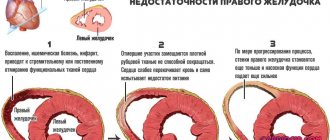Coma
Diabetes
is an endocrine disease associated with
absolute
insulin deficiency (type 1 diabetes mellitus, insulin-dependent) or
relative
(type 2 diabetes mellitus, non-insulin-dependent).
Diabetic coma
- one of the most severe complications of diabetes mellitus, resulting from absolute or relative deficiency of insulin and metabolic disorders. There are two types of diabetic coma: hypo- and hyperglycemic.
Hypoglycemic coma
develops with a sharp decrease in blood glucose levels to 2-1 mmol/l. Occurs due to a violation of the diet, an overdose of insulin, or the presence of a hormonal tumor (insulinoma).
Clinical picture
hypoglycemic coma is characterized by loss of consciousness, psychomotor and motor impairment, hallucinations, clonic and tonic convulsions. The skin and mucous membranes are sharply pale, moist, there is profuse sweat, tachycardia with relatively normal blood pressure values, rapid, shallow, rhythmic breathing. Blood glucose levels decrease
Intensive therapy:
20-80 ml of 40% glucose solution is immediately injected intravenously. If it is possible to control blood glucose levels, maintain it within 8-10 mmol/l by administering a 10% glucose solution with insulin.
According to indications, glucagon, adrenaline, hydrocortisone, cocarboxylase, and ascorbic acid are used.
For the prevention and treatment of cerebral edema, mechanical ventilation is performed in hyperventilation mode, intravenous infusions of 20% mannitol.
Hyperglycemic coma.
Blood glucose concentrations sometimes reach
Clinical picture
hyperglycemic coma is characterized by a lack of consciousness, the skin and mucous membranes are dry, warm, moderately pale or hyperemic.
You often smell acetone
on your breath. The eyeballs are sunken, “soft”, the pulse is rapid, blood pressure is reduced. Bradypnea, respiratory rhythm disturbances (Kussmaul type), polyuria, agitation, convulsions, and increased reflex activity are noted.
Intensive therapy.
Correction of hyperglycemia is carried out by administering insulin. Preference is given to short-acting insulin as it is more “controllable”. The most effective is intravenous drip administration using dispensers at a rate of 6-10 units per hour under constant monitoring of blood glucose concentration. Depending on the level of hyperglycemia, the first dose can be increased to 20 units. Correction of metabolic acidosis should be aimed at activating buffer systems and normalizing the functions of the cardiovascular and respiratory systems, oxygenating the blood, improving microcirculation and perfusion of organs and tissues.
What is hyperglycemic (diabetic) coma
Hyperglycemic (diabetic) coma
- a relatively slowly developing condition associated with an increase in blood glucose levels in diabetes mellitus and the accumulation of toxic metabolic products
Causes of hyperglycemic coma
This condition is an acute complication of diabetes mellitus. The main cause of coma is a deficiency of insulin in the blood. In type 1 diabetes, it is the first manifestation in patients who do not know that they have the disease. In the second type, severe hyperglycemia usually occurs due to improper treatment, dietary disorders, and lack of blood sugar control.
Common factors leading to decompensation include:
- incorrectly selected dose of insulin or tablets for the treatment of diabetes;
- late transfer of patients with type 2 disease to insulin;
- faulty syringe pen or pump for administering the hormone;
- expired medication;
- the patient does not know how to change the dose when blood glucose increases or does not carry out regular measurements;
- independent drug replacement;
- refusal of treatment;
- the onset of pregnancy;
- stress;
- injury or surgery;
- acute inflammatory process or exacerbation of chronic pathology;
- heart attack, stroke;
- infection;
- disruption of the pituitary gland and adrenal glands;
- taking medications that can increase glucose levels (adrenal hormones, estrogens, diuretics from the thiazides group);
- severe pain syndrome;
- changes in sugar in labile juvenile diabetes.
We recommend reading the article about diabetic coma. From it you will learn about the types of diabetic coma, signs and symptoms, as well as what the patient’s blood sugar and breathing will be like, first aid and the diagnosis of diabetic comas.
Find out more about preventing diabetes complications here.
Prerequisites
Pathology occurs in diabetics when the underlying disease is not treated correctly.
This condition can be caused by:
- The patient refuses to take insulin.
- Use of low-quality medications or medications that have expired.
- Irregular supply of insulin.
- Non-compliance with the diet, increasing the intervals between meals.
Read the article about what dosage of insulin is considered lethal.
Often, coma occurs in a patient with undiagnosed diabetes (prediabetes).
Additional causes of hyperglycemic coma:
- Diseases of an infectious/inflammatory nature.
- Hormonal imbalances in women or men.
- Surgical operations.
- Psycho-emotional problems and stress.
Hyperglycemic coma is also possible in women during pregnancy.
Development mechanism
Due to insulin deficiency, glucose is in increased concentration in the blood. In this case, the cells suffer from energy deficiency, since insulin is needed to carry out its molecules. In response to energy starvation, counterinsular (opposite to insulin) hormones enter the blood from the adrenal glands and pituitary gland.
This is how the body protects itself from lack of nutrition. This causes an increasing increase in blood sugar, its excretion in the urine, and loss of fluid and microelements.
Viscous blood provokes oxygen deficiency in the tissues; the breakdown of glucose occurs along an oxygen-free path (anaerobic glycolysis). The level of lactic acid in the blood increases. To nourish the cells, hormones from the pituitary and adrenal glands cause the breakdown of fat, since glucose is not available.
As a result of this process, many ketone bodies are formed. This is the name of acetone and acids - acetoacetic and hydroxybutyric. They shift the blood pH level to the acidic side. A ketoacidotic state develops with depression of brain function. In the absence of the required amount of insulin, it transforms into coma.
Hyperglycemic coma - pathogenesis
For patients with diabetes, hyperglycemic coma is not a surprise. The condition never comes on abruptly. If the patient's pancreas secretes insulin in normal quantities, the problem will only have to be encountered in the event of kidney dysfunction. The pathogenesis of hyperglycemic coma looks like this: first, glucose gradually increases in the plasma, as a result of which metabolic processes change at the cellular level.
Another thing is hyperglycemic coma due to a lack of insulin. The body begins to lack energy, and it tries to get it by converting proteins and fats into glucose. The kidneys cannot work fast enough to remove all waste products. Ketone bodies begin to accumulate, and as a result, the body has a double burden - lack of energy against the background of diabetic ketoacidosis.
Symptoms in adults and children
Signs of hyperglycemia increase gradually. Usually the transition to an extremely serious condition occurs within 2-3 days; rarely, diabetic ketoacidosis occurs within a day. The stages of progressive decompensation are considered to be precoma, moderate and complete coma.
Prekoma
At an early stage, the patient's thirst increases and urine output increases. Patients are concerned about severe dry mouth, tightness and flaking of the skin, soreness, and burning in the nasal passages. If the increase in symptoms occurs gradually, then weight loss, severe weakness, complete loss of performance, poor appetite, nausea, and tachycardia become noticeable. During this period, the sugar content increases to an average of 20 mmol/l.
Moderate coma
At this stage, due to the accumulation of ketone bodies, abdominal pain, irritability, nausea and paroxysmal vomiting appear, which does not provide relief. Headache, lethargy, and constant drowsiness increase due to suppression of brain function. There is noisy breathing, and the smell of acetone is heard from the mouth. The pulse increases even more, the pressure drops
According to the predominant symptoms, several types of coma are distinguished:
| Types of coma | Symptoms |
| Abdominal | Irritation of the solar plexus area by ketone bodies causes intense pain in the abdomen, it intensifies due to overstretching of the intestines and stopping its movements, enlargement of the liver; |
| Vascular | Accompanied by a sharp drop in pressure, collapse, rapid heartbeat, pain in the heart area, and rhythm disturbances. Due to the loss of potassium in the urine, infarct-like changes can be detected on the ECG; |
| Renal | Protein and nitrogenous bases are lost in the urine, copious urination decreases and can completely stop with increasing renal failure; |
| Brain | Body temperature rises, the neck muscles become stiff, it is difficult to press the chin to the chest when lying on your back; |
| Mixed | It has signs of several forms. |
Complete coma
It begins from the moment of loss of consciousness. Reflexes decrease and then become undetectable. Characterized by:
- severe arterial hypotension;
- decreased urine output;
- heart rhythm disturbances;
- noisy, irregular and infrequent breathing;
- decreased body temperature;
- tension of the anterior abdominal wall;
- cessation of perception of the surrounding world.
Complications
Due to the late start of therapy or an incorrectly selected dose of insulin, pulmonary edema begins. Loss of fluid and high blood viscosity provoke the development of vascular thrombosis. Children may develop cerebral edema with a fatal outcome against this background. Low blood pressure and reduced blood volume cause shock.
The causes of death of patients can be:
- a decrease in potassium in the blood below a critical level with cardiac arrest;
- low circulating blood volume – hypovolemic shock;
- heart failure with rapid fluid administration;
- accession of infections;
- the formation of blood clots in the arteries supplying the brain and heart;
- acute renal failure.
First aid
When the precoma stage occurs and the patient sufficiently understands his condition, home treatment can (as an exception) be carried out, subject to mandatory examination of the patient by a doctor, as well as the ability to control blood sugar. Therefore, for any severity of coma or warning signs of its development, the main thing is to immediately call an ambulance.
Actions of relatives
The patient must be placed on a horizontal surface and provided with full access to fresh air. The belt and collar must be unfastened. When vomiting, you should turn your head to the side to avoid blocking your airways.
If the patient is unconscious, and relatives have not observed a gradual deterioration of the condition, then it is strictly forbidden to independently use any medications. This may be a hypoglycemic coma associated with a sharp drop in blood sugar, in such cases the administration of insulin will be fatal.
If there is no glucometer and the patient can swallow, then it is recommended to give hot tea with a teaspoon of sugar before the doctor arrives in all doubtful cases, since this amount of glucose will not significantly change the situation in hyperglycemic coma, and if glycemia drops, it can save the patient’s life.
When to give insulin
After accurately measuring the concentration of sugar in the blood, the doctor recommends injecting short-acting insulin into the muscle in an amount of 10-15 units or adding 10% to the dose already used. You need to completely remove fats from your diet, replacing them with complex carbohydrates. It is necessary to take alkaline mineral waters (Borjomi, Essentuki 4 and Essentuki 17), gastric lavage and cleansing enemas are also prescribed.
How is the disease treated?
When the first signs of hyperglycemic coma appear, it is necessary to immediately do a sugar test. In addition, a urine test is performed to find out whether ketone bodies are present in the body. If the patient has not yet fallen into a coma, but says that he is worried about drowsiness, weakness, and a frequent desire to drink, then you need to ask whether he takes insulin. If the person answered positively, then emergency assistance should be carried out, namely, administer the drug, give him water to drink and call the hospital.
Emergency first aid for hyperglycemic coma, which must be carried out before doctors arrive, should be carried out sequentially. While waiting for paramedics to arrive, you should do the following:
- Place the patient in a horizontal position.
- If you have a belt, belt, tie, then you need to loosen them, and if you are wearing tight clothes, then unfasten them.
- Carefully monitor the position of the tongue, do not allow it to sink.
- Give an insulin injection.
- Measure your blood pressure periodically; if it drops, give you some medicine to take to increase it.
- Give the patient more water to drink.
Upon arrival, doctors take the patient to the clinic. There, specialists provide the following treatment for hyperglycemic coma:
- First of all, insulin is administered in the clinic by stream and then by drip.
- The stomach is washed and the intestines are cleaned using an enema with a 4% sodium bicarbonate solution.
- Place the patient under a drip containing saline solution, Ringer's solution.
- Every 4 hours, 5% glucose is administered.
- When treating hyperglycemic coma, another 4% sodium bicarbonate solution is used.
- At the same time, doctors must measure blood pressure every hour and determine the degree of hyperglycemic coma.
What consequences might arise?
If coma was detected in a timely manner and correct treatment was carried out in young and middle-aged patients, then the pathology does not cause any dangerous consequences. If the disease is not diagnosed in time and the patient remains in a coma for a long time, if the patient is still an elderly person, the following complications may develop:
- Pulmonary embolism, cerebral edema.
- Aspiration pneumonia.
- Speech and motor activity disorders.
- Stroke or myocardial infarction.
Children who have suffered a coma may experience mental disorders. In women expecting a child, the fetus may die inside the womb.
Diagnosis of the patient's condition
Diagnosis problems usually arise with the abdominal and cerebral form of hyperglycemic coma. Such patients may be mistakenly admitted to surgery or neurology due to suspected acute abdomen or stroke. The final conclusion is made after an urgent blood test. It contains:
- increased glucose more than 13-15 mmol/l;
- sugar and ketone bodies in urine (rapid tests);
- decrease in blood pH level to 7.25;
- low sodium and potassium (up to 135 and less than 3.5 mmol/l);
- high cholesterol (from 5 mmol/l);
- leukocytosis, blood thickening.
Chest X-ray
In order to exclude a heart attack, it is important to perform an ECG, if necessary, with a potassium test. Patients are prescribed a chest x-ray due to the high risk of developing secondary pneumonia.
Treatment of hyperglycemic coma
Therapeutic measures are carried out in several areas.
Restoring fluid volume
From the 2nd hour, 500 ml is administered intravenously over 60 minutes; as the condition normalizes, the rate decreases by 2 times. Total fluid loss in comatose patients can reach 6-7 liters. Their replenishment is carried out slowly, since the development of pulmonary and cerebral edema is possible with accelerated rehydration. At the same time, the solutions correct the loss of potassium and restore normal blood pH levels.
Insulin therapy
After the first bolus (large) dose, treatment is continued by intravenous drip administration of the hormone. Constant monitoring of the concentration of ketone bodies and blood glucose is required (at least every hour). After reaching a glycemia of about 13 mmol/l, a 5% glucose solution begins to drip in order to prevent a hypoglycemic state (drop in glucose) and create minimal glycogen reserves in the liver.
The insulin dose is reduced by 2 times, and after 10 mmol/l they switch to subcutaneous injections. You cannot reduce sugar by more than 3 mmol/l on the first day.
Normalization of blood circulation indicators
To improve microcirculation, it is recommended to administer anticoagulants (Heparin, Fraxiparin) and antiplatelet agents (Dipyridamole). The work of the heart is supported by “Cordiamin”, “Riboxin”, antispasmodics and potassium are administered. If there is a threat of developing a pulmonary or urinary infection, antibiotics are indicated.
Prevention measures
To prevent an increase in blood glucose concentrations, the patient must clearly understand the clinical picture of hyperglycemic coma and identify its precursors. The patient should be warned about the consequences of incorrectly administering insulin or refusing treatment, or independently replacing any hypoglycemic drug with a similar composition or (which is much more dangerous) with a dietary supplement.
It is also important to explain the need for strict adherence to the diet and recommendations for daily dosed physical activity. If there are any signs of ketoacidosis, you should immediately call an ambulance.
We recommend reading the article about the types of diabetes. From it you will learn about the types of diabetes mellitus, laboratory diagnostics, as well as which type of diabetes mellitus is more dangerous.
Find out more about diabetes in children here.
Hyperglycemic coma is considered an acute complication of diabetes, which is accompanied by increased levels of glucose and blood ketones. It manifests itself as increased thirst, excessive urination, dry skin and mucous membranes, the smell of acetone from the mouth, and pain in the abdominal area. When the body is intoxicated, headaches and confusion appear.
For diagnosis, you need to conduct a blood and urine test. Treatment takes place in intensive care with the administration of short-acting insulin and electrolyte solutions.
Useful video
Watch the video about hyperglycemic coma:
Similar articles
- Diabetic coma: signs, symptoms, consequences...
Depending on the type of diabetic coma, signs and symptoms, even breathing, differ. However, the consequences are always severe, including death. It is important to provide first aid as soon as possible. Diagnosis includes urine and blood sugar testing. Read more - Suspicion of diabetes: examinations, tests, diet, what...
Diabetes may be suspected if there are accompanying symptoms - thirst, excessive urine output. Suspicion of diabetes mellitus in a child can only arise during a coma. General examinations and blood tests will help you decide what to do. But in any case, you will need a diet. Read more
- Diabetes mellitus in children: causes, symptoms, types...
Often the birth of children from parents with diabetes leads to the fact that they also suffer from the disease. The reasons may also be autoimmune diseases and obesity. Types are divided into two - first and second. It is important to know the characteristics of children and adolescents in order to diagnose and provide assistance in a timely manner. There is prevention of the birth of children with diabetes. Read more
- Prevention of diabetes complications for types 1, 2, in children...
Prevention of complications of diabetes is carried out, regardless of its type. It is important in children and pregnancy. There are primary and secondary, acute and late complications in type 1 and type 2 diabetes. Read more
- What are the types of diabetes, how to determine...
You can figure out what types of diabetes there are and determine their differences by what a person takes—whether he is insulin dependent or on pills. Which type is more dangerous? Read more
Symptoms
Depending on the etiology, hyperglycemic coma develops over several hours or days. The body is poisoned by the resulting ketones, the acid-base balance is disturbed, and symptoms of dehydration and hypovolemia appear. This condition is called precoma.
Clinical warning signs:
- feeling of thirst, dry mouth and skin;
- polyuria;
- decreased activity and overall performance;
- stomach pain, vomiting, diarrhea;
- loss of appetite;
- impaired consciousness, drowsiness, irritability (develop gradually).
Muscle tone may decrease. A stench emanates from the patient’s mouth - the smell of acetone or rot. Breathing becomes deep and noisy. If this condition lasts for several days, a decrease in body weight may be observed.
In 50% of patients with hyperglycemic coma, manifestations of pseudoperitonitis are observed: tension and pain in the abdominal wall, painful abdomen, peristalsis of moderate intensity. Such symptoms appear as a result of the activity of ketones in the gastrointestinal tract.
Signs of complications in adults and children are almost the same.









